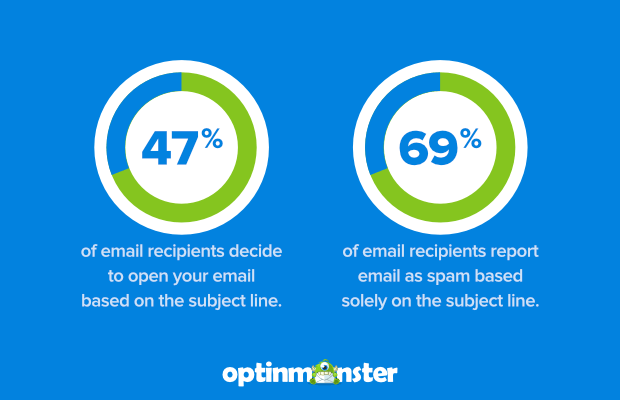They Signed Up, Why Won’t They Open?
You spend time writing amazing emails. Hours of thoughtful planning, and perfect execution. You send the email out, and only eight percent of your list opens the email. Why is that? You had a compelling capture page, your email relates to your offer, plus you have offered extra bonuses!
You have done everything right as far as you can tell, so why are they not opening? I am here to break the hard truth to you, it’s your subject line. It’s boring, it’s common, and they brush right past it, or worse, they delete it.
According to a study done, forty seven percent of people open an email based on the subject line alone. What’s even more disturbing is that up to sixty nine percent of recipients will report spam based on the subject line alone.

It is talked about far less than it should be, and practiced even less than that. I am on a ton of email lists and to be honest I open emails from about five people or companies regularly. I rarely report people, as I believe most people aren’t trying to be malicious. They just don’t know what they don’t know.
For that reason I want to show you how to write a subject line that inveigles your reader to open! Come with me and see what it takes to have your leads eagerly await and open your emails!
Three Parts Of A Subject Line
When I look at a subject a line I have found there are three very distinct parts. And as much as I hate to use a fishing analogy, it really does work in a similar fashion. What is it you see when you look at a subject line? You see something that grabs your attention, a part that tells you what to do, and some punctuation.
I really started watching this in emails that I opened and it breaks down into three distinct parts. Hard to believe in just a few short words there could be so much psychology, but there really is. Those three parts are just like fishing. There is the cast, the hook and the bait. Let’s explore each one more.
The Cast:
This is the overall subject of the email itself. What it is the email is about. It is the message under the message. Let’s look at one of my subject lines as an example, and illustrate what I mean.
Subject: Your Four Keys To Excellence…
The cast of this email, or overall subject is “How to become excellent”. It is simple, straight forward, but says if you open this email you will become excellent.
The Hook:
You have heard this term before, you have to hook your reader. The reality is, each line in an email has to entice the reader to read the next line. If they don’t read every line, they miss the message, they don’t click and you don’t make money.
In our subject line, “Your Four Keys To Excellence…”, what is the hook? A hook grabs your attention. You already know that if you open this email you will be shown how to be excellent, BUT, the HOOK is the fact that there are only four keys to get there.
The hook shows the reader that what you are offering as an overall subject is easy to attain, or will take very little work! You want to save them time, money, or make their lives easier. Our hook shows that point, and should express it well. This particular subject line had a forty percent open rate.
The Bait:
This may be poorly named, but the bait is your punctuation. In this subject line I used an ellipsis. An ellipsis indicates that there is more to come. It shows an unfinished thought. Human psychology can not have an unfinished thought. It has to see the thought through.
When the reader sees something like that it essentially forces them to open to see it through. There are varying punctuations and when used correctly, they compel the reader to open. A question mark if you ask the right question. A period that says your thought is finished and it appears you don’t want them to read it. This entices the reader to open.
Your punctuation is the part that gets them to bite and hang on. Once they have bitten and are in, your email is now open! The key here, is to make that subject line relate seamlessly to what they are about to read.
This is the part where people go off the rails. They write this amazing subject line. It entices almost everyone who reads it to click on their email. Only to find once the email is open that the subject line has nothing to do with the contents. This error costs you clicks and sales.
When you are building a story based email, you have to take these three points into consideration. Because you are using stories you are familiar with, the subject lines will actually come to you easier than you think. My rule of thumb is to write the email first and then spend time coming up with the subject line.
Seven Ways To Hook Your Reader
This section shows types of subject lines that encourage readers to open your email. It is important to understand that you will have to use all of them at some point to ensure diversity and originality. Once you have full trust of your readers, it won’t be AS important, but I would make sure to always have a great subject line. It guarantees opens and higher click throughs.
1) Drive FOMO
One of the biggest factors in human nature is the fear of missing out. If your subject lines shows that the reader is going to miss out on something, they have to have a look. It almost doesn’t matter what it is, if they are missing it, they need to look!
The fear of missing out is what has driven social media marketing to the level it is at. People show a snippet of their lives and people immediately have to know what they are doing, where they are doing it, and they have to copy it. Trends are not because a lot of people are doing something. Trends are because people are showing they aren’t missing out.
2) Funny, Sarcastic Or Sassy
Laughter really is the best medicine. If you can have a reader laughing to themselves, or laughing out loud before they open your email, you are golden. It still amazes me how much more people hear when they are laughing at what it is you are telling them.
People remember jokes, and they remember sarcasm. Not only do they remember it, they share it! So if your subject line is hilarious, and then you tell a compelling funny story to boot, the likelihood of them sharing your stuff is increased exponentially!
3) Appeal To Your Readers Vanity
If you can’t make people laugh, that’s ok. Appeal to their vanity. People want to feel good about what they are buying. They want to know it’s trendy and they want to know it will make them important. It is a little mean, but if you can entice a person’s vanity with your subject line, you will get the email opened. This will get you that much closer to a sale.
4) Provoke Greed
Human nature is that we always want more. We want more for varying reasons, and some of them are noble. Some of them are self serving, but when you provoke greed, it puts the reader into a buying mood before they even read your email.
Everyone is moved by the almighty dollar and if your subject line offers a solution to a shortage of money, your reader is more likely to open. Just be sure that your copy relates to the subject line.
5) Reward Sloth
Sloth is such a hard word, but people want the easy way out of anything. Humans desire to have the most, by doing the least. If you have a product that does all of the difficult things automatically, present that in your subject line.
Show your potential customer that your product makes things super easy and requires little work from the end user. Find a product that is well built, and user friendly, then highlight it in your subject line.
6) Poke At Pain Points
If you have constructed your capture page properly, your follow up should stay on track. You are offering a solution to a problem. That problem is what is known as a pain point. All that means is that you highlight the problem they have, and then show your solution to that problem.
However, you have to be careful in this, because poking too hard into that pain might cause the reader to leave. It’s important to emphasize that this is a psychological venture. You have a real solution to a real problem, and it’s ok to mention that, but don’t harp on either side. Mention it, then mention the solution.
7) Sell It, Without Selling It
Such a strange statement. Sell it without selling it. What is the goal of our marketing? It is building trust in our readers, which in turn means they will consider buying things you recommend. You have to be willing to take the time to get to know what your subscribers need.
Your subscribers signed up to your list for a reason. It may be the main thing you are recommending, or it may be related to that offer. If it isn’t that offer, it is your responsibility to learn what the real need is, and then offer a solution that will solve that problem!
Leverage Retargeting (Advanced Bonus Tip)
Retargeting is a strategy that you will learn about as you get better at marketing. I will give a brief overview of what it is here. When a prospect lands on your page and takes an action, and then somewhere in the process they leave your site, or don’t make the purchase, you need to be able to reach back out to them. This is what is known as retargeting.
What you need is an email marketing software that allows for what is called triggers. These triggers are set up to fire in the event a certain action is either completed, or it is not completed. If a person gets to the checkout page and then leaves, your retargeting would send them a reminder that they have items in their cart, and a chance to complete the transaction.
Triggers can be set up to drive a person in several directions in a funnel based on their responses to questions, or actions taken on your website. It is a pretty advanced technique that will be discussed in a more in depth article later.
Thanks for being here, comment like and share! Take your self improvement to another level and read about “Your Four Keys To Excellence“. Stay Hungry!


